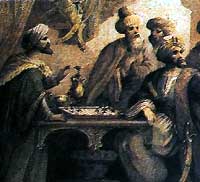Balansyia - The Muslim Civilization
711 - 1238
 The
peoples who crossed the Gibraltar straits in the 7th century AD are collectively
called "Muslims" precisely because it was the only thing that
they had a common. It would be incorrect to call them Arab, as by that
time the Muslim Empire had assymilated many peoples. In Spain, they are
usually called "the Moors" (los Moros). The
peoples who crossed the Gibraltar straits in the 7th century AD are collectively
called "Muslims" precisely because it was the only thing that
they had a common. It would be incorrect to call them Arab, as by that
time the Muslim Empire had assymilated many peoples. In Spain, they are
usually called "the Moors" (los Moros).
The Muslim invasion of Valentia was more than just another era. It is
what historians call a "rupture of historic process", when a
normal course of social evolution is abruptly interrupted by something
radically different and alien.
The Musims did not just bring a different language and a different religion,
which is a radical change in itself, they also brought a new society.
In the social fabric of the Muslims, tribal family ties and enthnic fragments
were much more important than hierarchy or territories. Curiously, the
importance of family and "clan" ties is still ingrained in Spanish
mentality much more than in most other European nations.
The expansion continued until the Moors reached the Pyrenees mountains
that separate Spain from France. There, they made a non-agression pact
with Charles the Great of France. This status quo would hold for sometime,
before the Christians started to push back in what is called the Spanish
Re-Conquista.
The Muslims were very tolerant to the locals, however. Religious freedom
and hereditary priviliges remained with the people of Valentia in the
new Balansiya. But over the course of time the tribal social order naturally
took over and the previous inhabitants dissolved into the Moorish population.
Balansiya blossomed. The Moors brought their intricate irrigation systems
(which evolved as a necessity in their scorched homelands) to the dry
terrains of Spain, practically turning Valencian countryside into a lush
garden. The people who worked the huerta (green fields) kept all the rights
to their patch of land, so the system was put in place to run the common
irrigation without conflicts. It was an almost utopically democratic Tribual
de los Aguas (The Water Court). To these days the Tribunal
meets every Thursday at midday in the centre of Valencia.
The explosion in population was also due to the Moorish superior medicine
and health care, such as putting spice in the food to prevent it from
going off, and mixing wine into drinking water to desinfect it.
It is curious to note that the two of Valencia's landmarks products came
from the Moors. Oranges have been the bulk of Valencia's trade well into
the XX century and they were brought from Africa by the Muslims. While
the paella, the world-famous Valencian culinary invention, would not exist
without the Moorish spices (particularly saffron).
 The
Muslim Empire was also very advanced in science, technology and arts.
Over the centuries of expansion, the Muslim civilization consumed ancient
Roman learning centres and studied the finds much more deeply than the
Europeans. In 1010 the Califate of Cordoba, of which Balansiya was a part,
broke up into a number of Taifas. Balansiya suddenly became a capital
of its own kingdom and the court promoted the arts and studies much more
strongly, as a way to consolidate its status. The
Muslim Empire was also very advanced in science, technology and arts.
Over the centuries of expansion, the Muslim civilization consumed ancient
Roman learning centres and studied the finds much more deeply than the
Europeans. In 1010 the Califate of Cordoba, of which Balansiya was a part,
broke up into a number of Taifas. Balansiya suddenly became a capital
of its own kingdom and the court promoted the arts and studies much more
strongly, as a way to consolidate its status.
Balansiya of those times was quite strictly ordered. The central square
with the main mosque (where the Cathedral
now is) was surrounded by houses of nobility. There was a luxurious Palace
of which the Crypt
of San Vicente Martyr was a part (it was converted into Royal Baths).
The city was strictly regimented into sections, merchants in one, nobility
in another, artesans yet in another, etc. The now bohemian Carmen
was already bohemian back then - it was the neighbourhood of artesans,
artists, entertainers and the likes.
You will have noticed how easy it is to get lost in Carmen. An insane
maze of little streets strips you of any bearings. This ancient Moorish
neighbourhood shows what the whole city was like in those times. The Moors
had strict ideas about privacy. To avoid crowds outside their doors they
preferred to have their own street leading to the house of their family,
or at least to a few houses of the same tribal group. In this way they
conserved privacy in an urban environment.
The Moorish Valencia occupied about a half of the present city centre,
from below Mercado Central to the top of Carmen.
Sights from the period:
Almirante
Baths | Water
Court | Portal Valldigna | Tossal
Gallery
Map: Location of Muslim
Valencia
|